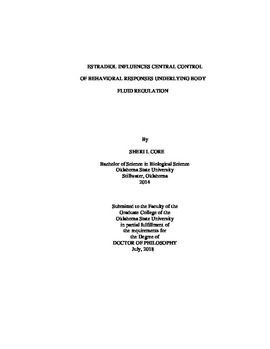| dc.description.abstract | Extracellular fluid depletion and body sodium loss produces physiological and behavioral responses to restore body fluid homeostasis, and these responses are influenced by sex hormones. Sodium depletion produced by the natriuretic-diuretic, furosemide (FURO) stimulates salt intake that increases progressively with multiple FURO treatments, a form of behavioral plasticity that is more pronounced in females. Hormonal, osmotic, and neural signals regarding perturbations in sodium balance are initially processed within neurons and glia of the hindbrain dorsal vagal complex (DVC). Thus, plastic changes to glia and synaptic proteins can alter the effectiveness of synapses in the DVC to propagate signals to forebrain areas involved in body fluid regulation and thereby produce behavioral plasticity such as, progressive increases in salt intake. Our objective was to determine estradiol's effects on brain plasticity associated with the detection of peripheral changes during sodium loss. Accordingly, ovariectomized female rats with and without hormone replacement were used to test estradiol's effects on the 1) the time course of changes in glia in the hindbrain DVC, 2) the behavioral and physiological responses to repeated FURO-induced sodium depletion, and 3) the changes in expression of specific synaptic proteins in the hindbrain DVC after multiple FURO-induced sodium depletions. Adult female rats were ovariectomized, allowed to recover for 7 days, and then given estradiol benzoate (EB; 10 mg/0.1 ml oil, sc) or oil vehicle (OIL; 0.1 ml, sc) each week for 3 weeks. Rats were given two s.c injections 1-hour apart of FURO (5 mg/kg, s.c.) or 0.15 M NaCl (ISO; 1.0 mL/kg). Separate groups of rats were used for immunohistochemical analysis of glial fibrillary acidic protein (GFAP) in the dorsal vagal complex 2 h and 18-24 h after FURO/ISO, for urinary sodium and volume excretion and water and salt intake after weekly FURO/ISO treatments, and for western blot analysis of GFAP, B-actin, and the synaptic protein calcium calmodulin kinase II (CaMKII). Water and salt intake was increased in furosemide treated rats compared to isosaline treated rats independent of number of depletions. Estradiol produced a greater increase in salt intake compared to oil-treated rats after first furosemide-induced sodium depletion. Repeated furosemide treatment altered the expression of GFAP and CaMKII in the DVC. Estradiol may alter expression of GFAP and CaMKII in the DVC. | |
